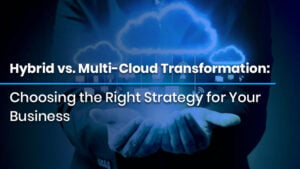
How to Strengthen Security Using CIS Controls and Posture Analysis
How to Strengthen Security Using CIS Controls and Posture Analysis Introduction In the fast-paced and ever-evolving world of cybersecurity, defending digital infrastructure goes far
Enhance your Skills in Cloud Computing , IP Networking , Microsoft , Artificial Intelligence , Cybersecurity and Many More . Come and Join IPSpecialist.

How to Strengthen Security Using CIS Controls and Posture Analysis Introduction In the fast-paced and ever-evolving world of cybersecurity, defending digital infrastructure goes far

How to Prepare for the AWS Data Engineer Exam Introduction With the world becoming increasingly data-driven, organizations are depending on cloud-based systems to store, process,

Hybrid vs. Multi-Cloud Transformation: Choosing the Right Strategy for Your Business Introduction In the digital-first economy of today, cloud transformation is no longer a
Table of Contents
In today’s data-driven business environment, leveraging real-time insights and advanced analytics is crucial for maintaining a competitive edge. Power BI, Microsoft’s leading data visualization and analytics tool, empowers organizations to transform raw data into actionable insights. When Power BI is integrated with cloud services, businesses can elevate their analytics capabilities, streamline workflows, enhance collaboration, and ensure data is accessible across the organization.
By integrating Power BI with multiple cloud platforms, businesses can retrieve data from various sources, creating a unified view that supports more intelligent decision-making. Some of the most commonly used cloud platforms for Power BI integration include Microsoft Azure, Amazon Web Services (AWS), Google Cloud Platform (GCP), Dropbox, and OneDrive.
Ready to master Power BI and take your data analytics skills to the next level? Explore IPSpecialist’s Comprehensive Courses! Our expert-led training covers all the key integrations, including Azure, Microsoft, Power BI, Networking, Cybersecurity, etc. Visit IPSpecialist.com today and join a community of professionals advancing their careers with industry-leading certifications and practical expertise.
Integrating Power BI with cloud platforms amplifies the potential of data analytics. Businesses gain access to real-time data, cross-platform compatibility, and scalability, among other advantages. Power BI retrieves, processes, and visualizes data from various cloud sources, allowing companies to harness data for more informed, data-driven decisions. Cloud services provide on-demand scalability, enabling businesses to handle large data volumes and react quickly to market changes. Moreover, seamless integration simplifies data workflows, boosts efficiency, and fosters a culture of data-driven decision-making.
Power BI’s integration with Microsoft Azure allows seamless connectivity with services like Azure SQL Database, Azure Synapse Analytics, and Azure Data Lake. This integration enables businesses to access and analyze real-time data, making it a robust solution for those leveraging cloud computing for analytics.
By integrating with AWS, Power BI users can connect to Amazon Redshift, Amazon S3, and other AWS services. This integration allows businesses to run advanced analytics on large datasets stored in the AWS cloud, supporting performance monitoring and strategic decision-making.
Power BI’s integration with Google Cloud Platform provides access to services such as BigQuery and Google Sheets. This allows businesses to retrieve and visualize data stored in the Google Cloud, which is ideal for organizations using Google’s cloud ecosystem for their data management.
Power BI integrates with Dropbox, allowing businesses to analyze and visualize files stored in their Dropbox cloud storage. This integration helps smaller companies relying on Dropbox for data storage to quickly and easily create reports and dashboards from their documents quickly and easily.
With OneDrive integration, Power BI users can retrieve and visualize data from Excel or other files stored in OneDrive. This is particularly advantageous for teams within the Microsoft ecosystem, offering seamless collaboration and access to up-to-date data.
Power BI’s integration with Genesys Cloud gives businesses insights into customer interactions, agent performance, and call analytics. By importing Genesys data into Power BI, organizations can create dashboards that help improve customer service strategies.
Integrating ServiceNow with Power BI allows IT departments to visualize service management data. With Power BI, users can monitor service tickets, assess incident management performance, and analyze trends for better IT operations.
Power BI’s integration with Salesforce offers a consolidated view of customer relationships and sales pipelines. This empowers sales and marketing teams to track leads, analyze performance, and make data-driven decisions.
For businesses using SAP ERP, integrating with Power BI enhances reporting on financial data, procurement, and HR analytics. Power BI’s ability to connect to SAP data enables more strategic decision-making through in-depth resource management insights.
Integrating Power BI with Snowflake enables businesses to run analytics on large datasets. Organizations can create unified reports from structured and semi-structured data by querying Snowflake data directly in Power BI.
Data scientists can perform advanced analytics in Power BI by integrating it with Python. This allows users to run Python scripts for machine learning, predictive models, and statistical analysis directly in Power BI.
Copilot integration brings AI-driven recommendations to Power BI users. With natural language processing (NLP) capabilities, Copilot makes it easier for non-technical users to generate insights and interact with data using conversational queries.
Cortana’s integration with Power BI enables voice-activated access to insights. Users can ask natural language questions to access reports and dashboards, making data more accessible for mobile and remote users.
Organizations from various sectors can benefit from Power BI’s integration with cloud services, including:
Integrating Power BI with cloud services unleashes the potential for advanced analytics, real-time monitoring, and collaborative data management. This powerful combination allows businesses to improve decision-making, optimize operations, and scale quickly. By utilizing cloud platforms like Microsoft Azure, AWS, GCP, Dropbox, and OneDrive, Power BI can transform into a central tool for driving data strategy and fostering business growth.
ServiceNow can be integrated with Power BI, enabling IT teams to visualize service management data and improve issue tracking and resolution.
Power BI offers native connectors to popular cloud platforms like Azure, Salesforce, and Google Cloud, providing secure and reliable integration for real-time data analytics.
Cloud integration enhances data accessibility, provides real-time insights, and supports team collaboration, enabling more informed and agile decision-making.
© 2025 All rights reserved | Privacy Policy | Terms and Conditions | Sitemap | Cookie Policy




